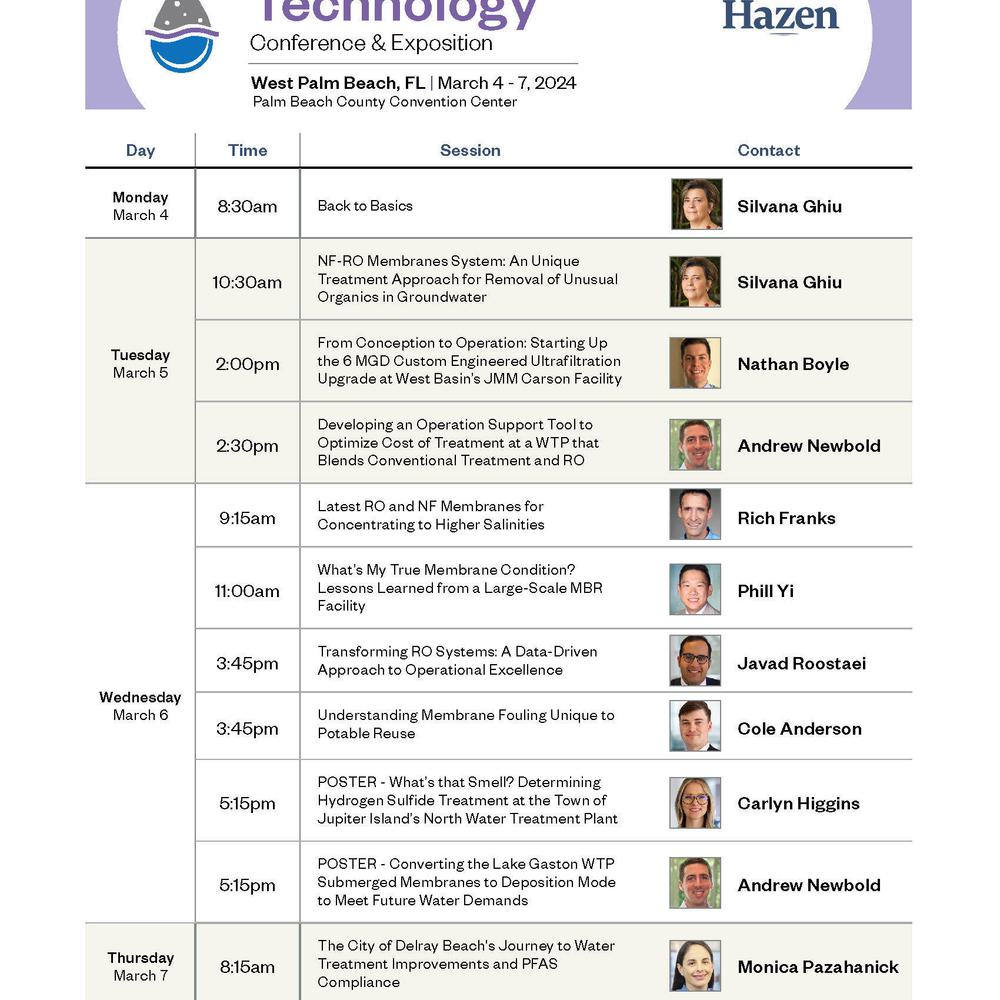Corrosion Control: Results from a National Survey
Last Modified Feb 04, 2022
Utility perspectives and corrosion control practices are evolving in response to updated industry policies, including the 2016 release of EPA corrosion control treatment guidance, anticipation of the Lead and Copper Rule (LCR) Long-Term Revisions, and numerous state-level LCR regulatory policy changes. In October 2019, the USEPA released draft LCR Revisions proposing the first major overhaul of the LCR since 1991.
To gauge current industry practices and trends related to corrosion control and LCR compliance, a utility survey was performed in March 2019. Survey responses were received from a diverse group of utilities nationwide with different sizes, source waters, and treatment processes. Survey questions were included to gauge utility challenges, concerns, and priorities related to LCR compliance and corrosion control treatment.
The results provide insight on current corrosion control trends and utility perspectives on the LCR. Overall, providing optimal corrosion control treatment was ranked as the most important task for utilities in the survey. Approximately 44% of systems with LSLs ranked LSL replacement with high importance. In terms of challenges, over 40% of systems indicated that coordinating LCR compliance monitoring was a primary challenge.
Characteristics of Participating Utilities
Utility contacts were planned to provide a diverse dataset. Over 350 utilities were contacted about the survey, and 60 responses were received. Figure 1 summarizes the characteristics of respondent utilities.
Related Topics:
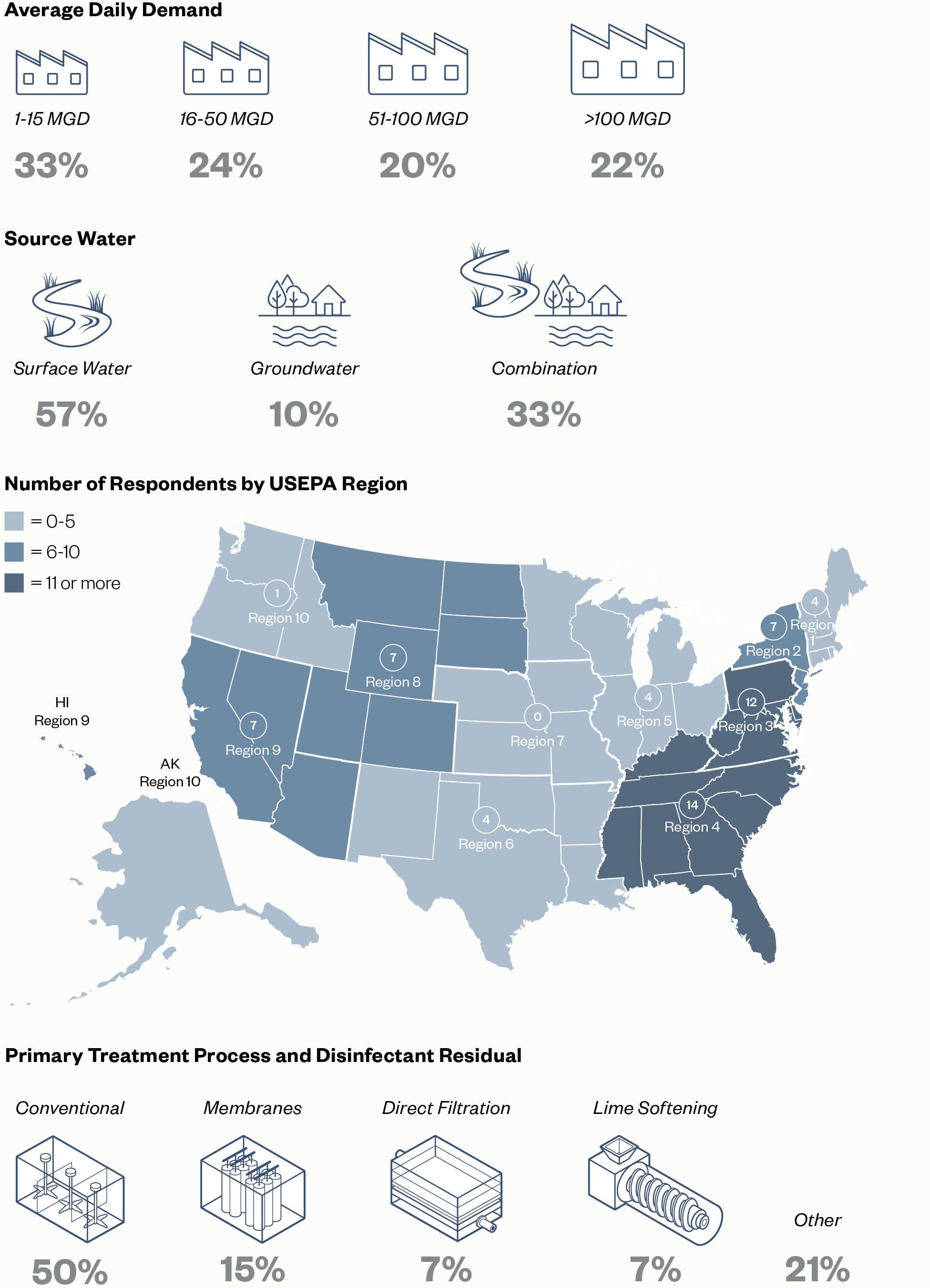
LCR Compliance Results
The LCR requires compliance sampling at customers’ taps at high-risk sites to monitor lead and copper release to drinking water. This sampling requires one-liter first draw samples after a minimum of 6 hours of stagnation and includes provisions for standard monitoring (every 6 months or annually) and reduced monitoring (a reduced quantity of samples every 3 years). The Action Level is exceeded if the 90th percentile lead or copper concentration is above 15 ppb or 1.3 ppm, respectively. An Action Level exceedance triggers a series of follow-up activities, including optimization of corrosion control treatment.
Approximately 67% of systems participating in the survey collect LCR samples every 3 years, with reported lead levels the lowest in these systems. Consistent with LCR requirements to return to standard monitoring every 6 months following an Action Level exceedance, the reported 90th percentile lead concentrations were higher in systems collecting tap samples every 6 months.
Action Level exceedances within the last 10 years were reported by approximately 12% of systems in the survey. Three of these systems also added a new water source or water treatment plant within the last 10 years. Not surprisingly, systems with LSLs were more likely to have experienced an Action Level exceedance, and approximately 25% of systems with LSLs reported an Action Level exceedance in the last 10 years.
The draft pre-publication LCR Revisions introduced a new “Trigger Level” of 10 ppb for lead. If 90th percentile lead levels exceed the Trigger Level, the system would be required to evaluate corrosion control treatment and perform LSL replacement according to a predetermined plan. While only 4% of systems in the survey reported a lead concentration above the Action Level in the most recent monitoring period, approximately 15% of systems reported a 90th percentile lead level above the Trigger Level. Thus, approximately 10% of systems that were below the Action Level would have been affected by the proposed Trigger Level. Interestingly four out of five systems in this range reported use of pH/alkalinity adjustment for corrosion control treatment.
Lead and Copper Rule Revisions Impacts
Hazen's interactive explainer outlines the proposed changes to the LCR and the impacts of those changes on water utilities.
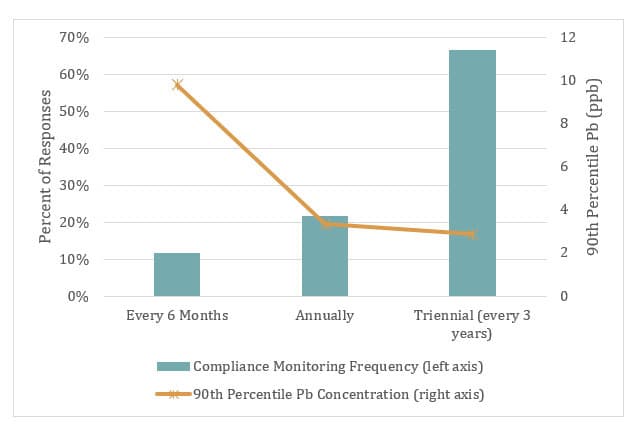
Corrosion Control Treatment Results
Utility responses were analyzed to characterize corrosion control treatment practices. The LCR describes use of pH/alkalinity adjustment or a corrosion inhibitor as corrosion control treatment strategies.
Overall, approximately 54% of systems reported use of a corrosion inhibitor, and 46% reported pH/alkalinity adjustment (Figure 2). Corrosion inhibitors were more often used in surface water systems (65% of surveyed systems). Groundwater systems more frequently used pH/alkalinity adjustment for corrosion control.
Corrosion inhibitors were more often applied in surveyed systems with a pH in the range of 7 to 8 (Figure 3). Systems with pH levels above 8.5 used pH/alkalinity adjustment for corrosion control treatment. These results are consistent with research and industry guidance indicating that orthophosphate corrosion inhibitors are generally most effective in the pH range of 7.2 to 7.8.
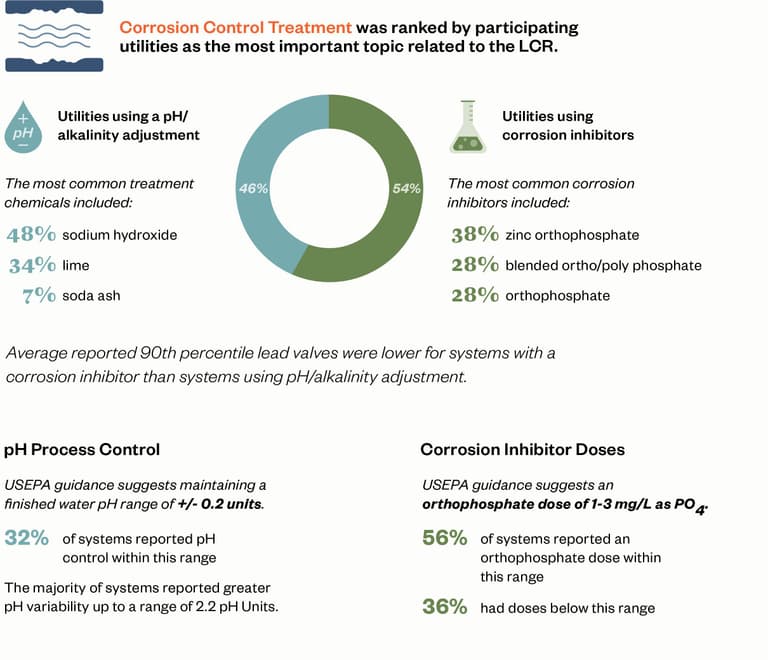
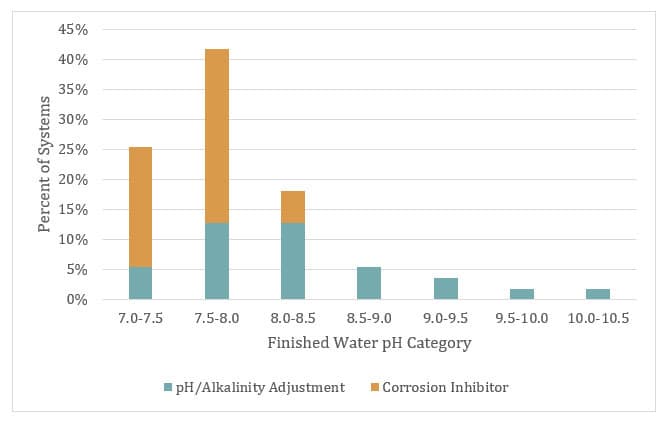
Figure 3. Corrosion inhibitors were more often applied in surveyed systems with a pH in the range of 7 to 8.
Corrosion Control Treatment Impacts on Compliance Monitoring Results. The average reported 90th percentile lead concentration was slightly lower in systems using phosphate-based corrosion inhibitors compared to systems using pH/alkalinity adjustment. This finding is consistent with results from a prior utility survey indicating that systems using orthophosphate-based corrosion inhibitors and pH values less than 7.8 had lower 90th percentile lead concentrations. However, other factors associated with source water, treatment, and water quality may influence observed lead levels and correlate with the likelihood for corrosion inhibitor use.
The average reported 90th percentile copper concentration was slightly lower in systems using pH/alkalinity adjustment (0.16 mg/L) compared to systems using corrosion inhibitors (0.26 mg/L). For systems using pH/alkalinity adjustment, the finished water pH was a critical factor affecting copper levels, and systems with higher finished water pH levels reported lower 90th percentile copper concentrations.
pH/Alkalinity Adjustment. Multiple chemicals are used to adjust finished water pH and alkalinity for corrosion control. The most widely used was sodium hydroxide (caustic), reported by approximately 48% of systems adjusting pH. With the exception of two groundwater systems using aeration, all other systems with an alkalinity greater than 100 mg/L as CaCO3 used caustic for pH adjustment.
Calcium hydroxide (lime) was also commonly used and was reported by 17% of systems. Caustic and lime increase pH but do not affect dissolved inorganic carbon (DIC), which is an important parameter for corrosion control.
In addition, only one utility responded that corrosion is monitored by checking the Langelier Saturation Index (LSI) monthly. The LSI represents the extent of calcium carbonate saturation in the water. This approach is no longer recommended for corrosion control in USEPA guidance and was proposed to be removed as an optimal corrosion control treatment technique in the pre-publication LCR Revisions.
Corrosion Inhibitors. Several systems noted that their corrosion control treatment strategy consists of a corrosion inhibitor and pH adjustment, consistent with corrosion control theory that pH control is critical for the effectiveness of orthophosphate.
A variety of corrosion inhibitors are available, including orthophosphate (e.g. phosphoric acid, or sodium orthophosphate), zinc orthophosphate, blended orthophosphate/polyphosphate, and silicate corrosion inhibitors. Zinc orthophosphate was the most-commonly reported type of corrosion inhibitor in the survey, but non-zinc orthophosphate and blended phosphate corrosion inhibitors were also commonly used.
Significant differences in 90th percentile lead concentrations between systems using orthophosphate and blended phosphate corrosion inhibitors were not found. However, 90th percentile copper levels were higher in systems with blended phosphate corrosion inhibitors (0.32 ppm) compared to systems with orthophosphate alone (0.10 ppb).
The 2016 USEPA corrosion control treatment guidelines recommend an orthophosphate concentration of 1 to 3 mg/L as PO4. Approximately 56% of participating utilities reported an orthophosphate dose in this range, while 36% of participating utilities had an orthophosphate dose less than 1.0 mg/L as PO4. The draft pre-publication LCR Revisions released in October 2019 require systems to evaluate orthophosphate doses of 1 mg/L as PO4 and 3 mg/L as PO4 as potential corrosion control treatment strategies.
Water Quality Parameter Process Control. The LCR requires systems to comply with specified Water Quality Parameters (WQP) ranges in finished water and in the distribution system to ensure that corrosion control treatment is consistently maintained. The USEPA corrosion control guidance suggests a finished water pH range of +/-0.2 units (i.e. a range of 0.4 pH units).
Approximately 32% of systems in the survey reported a finished water pH range within this goal. The draft pre-publication LCR Revisions include provisions to increase the emphasis on WQP monitoring and include state reviews of WQP data during sanitary surveys.
Corrosion Testing. State regulatory agencies are increasingly requiring systems to perform corrosion testing to identify optimal corrosion control treatment or evaluate source water or treatment changes.
The majority of systems in the survey did not perform corrosion testing within the last 10 years. Among the testing methods reported in the survey, pipe loop testing was the most-commonly used and was reported by approximately 16% of systems. The second most-commonly reported corrosion testing method was coupon weight loss testing (11% of systems). Industry guidance indicates that coupon weight loss testing has limited applicability for evaluating corrosion control for LCR compliance.
Water Quality and Treatment Impacts. Prior research has demonstrated that increased galvanic corrosion of lead can occur in situations with elevated chloride-to-sulfate mass ratio (CSMR) values. A wide range of CSMR values were reported in the survey, with higher CSMR levels in systems with groundwater sources.
Prior research has found increased potential for galvanic corrosion of lead with CSMR values above approximately 0.5, especially with alkalinity levels below approximately 50 mg/L as CaCO3. Approximately 75% of the systems in the survey had CSMR values greater than 0.5. No significant correlations between reported CSMR values and 90th percentile Pb values were observed in this survey.
Overall, approximately 27% of systems in this survey reported that lead service lines (LSLs) were present, and an additional 12% reported that the presence of LSLs is unknown or that only lead goosenecks are present.
Large utilities were more likely to report the presence of LSLs, and approximately 54% of systems in the survey with an average daily demand greater than 100 MGD contained LSLs. The majority of larger utilities (>51 MGD) with LSLs reported that they had LSL replacement programs, while utilities with an average daily demand of less than 15 MGD did not have existing LSL replacement programs.
The draft LCR Revisions increase the emphasis on LSL replacement and contain provisions to encourage and accelerate replacement, including development of a service line inventory and a LSL replacement plan.
Utility Experiences
Utility Priorities. Participating utilities were asked to rank six items related to lead and copper corrosion in terms for relative importance. The responses indicated that providing optimal corrosion control treatment is the top priority for utilities and that coordinating with customers for compliance sampling is also of high importance.
Although some systems have experienced increased lead in drinking water and Action Level exceedances following source water or treatment changes, managing the impacts of source water or treatment changes was generally of the lowest importance topics to utilities in the survey.
Utility Challenges. Each utility was asked to describe their greatest challenge related to corrosion control and LCR compliance in an open-ended question; some participating utilities shared more than one key challenge.
The reported utility challenges in the relative order of priority were:
- Sample Collection and Customer Participation – Over 40% of systems indicated that coordinating LCR compliance monitoring was a primary challenge. Surveyed utilities described challenges associated with identifying and retaining sufficient compliance sampling participants and the potential inaccuracies associated with samples collected by customers. Coordinating compliance sampling was also the second most important topic for respondents, emphasizing the criticality of this task for utilities.
- Corrosion Control Treatment – Responses described the challenges associated with identifying and maintaining optimal corrosion control treatment. Some systems also reported a lack of corrosion control training resources and difficulties with corrosion control chemical feed equipment.
- LSL Replacement – Many systems in this category described the challenges associated with locating and identifying LSLs, or with funding and coordinating private LSL replacement. Participants in California specifically noted the State regulations for LSL inventory and replacement.
- Regulatory Changes – Some systems reported that changing regulations and uncertainty about future regulations was a primary challenge.
- Public Perception – Several systems indicated that they face challenges associated with the public health impacts of lead in drinking water.
- Consecutive System Coordination – Water wholesalers described the challenges of coordinating corrosion control treatment changes with multiple interconnected consecutive systems. Consecutive systems expressed concerns about the potential impacts of water quality and treatment changes in purchased water.
- Unintended Consequences – Participants specifically described concerns with changing pH on DBP compliance and with wastewater treatment impacts associated with increased phosphorus concentrations from corrosion inhibitors.
- Source Water Changes – Several systems expressed concerns about the impacts of source water quality on corrosion control, including increased chloride levels from road salt and variations in natural silica levels in source water.
Distribution System Pipe Materials. Corrosion control treatment and water quality influence corrosion and degradation of distribution system pipe materials. Over half of systems in the survey expressed concerns about cast iron pipe in the distribution system, since cast iron pipe corrosion and tuberculation can reduce pipe hydraulic capacity and lead to distribution system water quality issues. Systems with cast iron pipe should consider the impacts of corrosion control treatment and water quality changes on iron corrosion to avoid potential unintended consequences.
Approximately 35% of systems expressed concerns about galvanized pipe in the distribution system. Galvanized iron pipe is a common source of water discoloration associated with iron release and particulate scale detachment and can also be a significant source of lead due to the presence of lead zinc galvanizing coatings and the sorption of lead to galvanized iron pipe scales.
Copper Pitting. In certain conditions, copper pitting corrosion can occur and lead to pinhole leaks and premature failure of copper pipe. Several utilities in the survey reported copper pitting or pinhole leaks. Copper pitting can influence corrosion control treatment, as the water quality conditions that promote copper pitting are generally correlated with low copper release to drinking water.
Conclusions
The survey results provide insight on current corrosion control trends and utility perspectives on the LCR. Key findings include:
- Utilities consider providing optimal corrosion control treatment as a top priority. Utility survey responses also highlighted a need for additional training and technical guidance to help utilities optimize corrosion control.
- Reported rates of orthophosphate use were somewhat higher compared to prior industry corrosion control surveys, and the survey results demonstrate that orthophosphate is effective for reducing lead release. 36% of systems had orthophosphate doses below the USEPA recommended range of 1 to 3 mg/L as PO4. The pre-publication LCR Revisions would require systems to evaluate specific orthophosphate doses of 1 mg/L as PO4 and 3 mg/L as PO4, which may prompt systems to further increase orthophosphate doses.
- Utilities perceive compliance sampling as the most challenging aspect of LCR compliance due coordination of customer-collected samples and identification of eligible sampling sites. Compliance sampling site selection criteria is proposed to change as noted in the proposed LCR Revisions, which may require many utilities to re-evaluate sample site selection and coordinate with customers to incorporate new sampling sites.
- Lead service line replacement was reported to be the second greatest challenge related to corrosion control. Participating utilities with LSLs were more likely to have an Action Level exceedance during the last 10 years and reported higher 90th percentile lead concentrations in the most recent monitoring period compared to systems without LSLs. The pre-publication LCR Revisions would require systems to develop a service line inventory and develop a LSL replacement plan. Required LSL replacement would be triggered by a “Trigger Level” or Action Level exceedance.
- The draft LCR Revisions introduced a new “Trigger Level” for lead of 10 ppb in addition to the Action Level of 15 ppb. Based on the survey results, it is anticipated that approximately 10% of system would be impacted by the proposed Trigger Level of 10 ppb.









